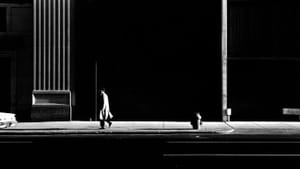Stay in the Loop
BSR publishes on a weekly schedule, with an email newsletter every Wednesday and Thursday morning. There’s no paywall, and subscribing is always free.
Photographer Ray Metzker: An appreciation

Innovator. Formalist. Intellectual searcher. Legatee of the American Bauhaus.
Ray Metzker, who passed away in early October at the age of 83, has been called all of the above. He has also been called one of the most important photographers of the second half of the 20th century.
These labels are accurate, albeit incomplete.
Ray, who was my mentor in graduate school and my friend and colleague after that, was one of the most important artists of the second half of the 20th century and first decade of this one. Despite the often brooding, mysterious, intense, and foreboding nature of much of his work, he had a whimsical, playful side to him as well. Light dances. Lines pulsate. Titles such as "Flutterbye" and "Hot Diggety" are hardly expressions of existential angst.
The last important body of work he completed, images of reflections in car windshields and bodies, was executed as late as 2009. These capped a career of relentless discoveries and summarized the qualities that set Metzker apart and defined his legacy: curiosity, an eye for the ordinary, and a resultant extraordinary vision in bold black and white. He could see in layers, combinations, simultaneity. Like the late modernist he was, he learned the lessons not only of photography but of art in general, distilled them, and synthesized his own take. He understood photographs were objects themselves and went about rethinking how they could be realized, how they could appear.
Low profile
Metzker was never a big star, nor did he seek celebrity. He wasn't even particularly famous most of his career — recognition came relatively early, but his profile was subdued for many years. He spoke of receiving little recognition from colleagues where he taught, but, then, he was too jealous of his time to work to let them intrude socially. He did, however, receive important recognition from the Guggenheim Foundation (twice), the National Endowment for the Arts, and other sources.
When I would tell people I had studied with him, they invariably would say, “Oh, yes, the photographer who did the composites.” These were clearly his breakthrough pieces, the ones that established him as a formidable figure. Not satisfied with the single image, Metzker explored multiple images, assembled or printed as uncut rolls of film, rhythmic and pulsating and dazzling. They were also quite large, well before the current era of huge prints, many of which are large simply because it is possible, not because the vision demanded it, as was the case with Metzker. The multiples were, ironically, predominantly one-of-a-kinds, another challenge to the notion that the photograph is endlessly reproducible.
But the reception of the multiples (or composites, as some labeled them) were hardly laurels upon which he rested. Double-frame images, single images, landscapes, nonrepresentational photograms, figures lying on the beach preceded and followed them and ultimately constituted a prodigious output in both numbers and quality.
Seeing what is to be seen
Ray's studio walls were covered with found objects, many of which did not make it into his work but clearly influenced it. He was a flaneur, roaming with and without his camera. To walk the streets of Philadelphia with Ray was to see them anew. He'd notice a new business or renovation underway and recall what was there previously. He would marvel at some architectural detail and suddenly stare at a shaft of light falling across a façade.
After graduate school and a stint in the military, Ray traveled in Europe for more than a year, taking walks and pictures, developing his film in makeshift “darkrooms” in hotels and pensions. When I asked him how he would work during that sojourn, he said simply, “One day I would walk out the door and turn to the left; the next day I would turn to the right.”
As arbitrary as that sounded to me then, I realized later he always carried what he called “terms” with him. Some thing or quality of light or forms had caught his attention on one of his walks, and he went out the next day with them in mind. He didn't have a specific picture planned, just these qualities that made pictures worth taking . . . and looking at. This approach was the key to what made Metzker an artist of importance and what made his work challenging. He understood that the artist begins his exploration by admitting what he doesn't know. Then he sets out to try and discover meanings.
Sign up for our newsletter
All of the week's new articles, all in one place. Sign up for the free weekly BSR newsletters, and don't miss a conversation.
